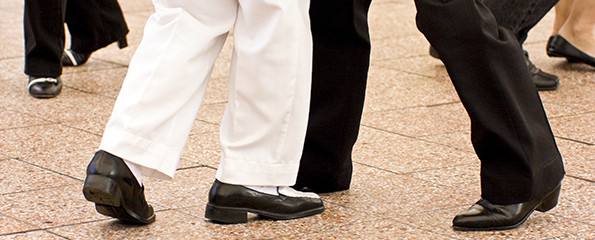Dance study puts people with Parkinson’s on the front foot
Brisbane researchers have proven that a community dance program can improve the health and wellbeing of people living with Parkinson’s disease.
In the first study of its kind in Australia, neuroscience, psychology and physiotherapy experts from QUT and The University of Queensland put Queensland Ballet’s (QB) pilot Dance for Parkinson’s program under the proverbial microscope to measure the benefits for participants.
The program offered a series of 75-minute classes that included structured exercises and creative movement activities accompanied by live music, followed by afternoon tea.
Participants learned parts of QB’s repertoire, including The Nutcracker and Romeo & Juliet, saw live QB performances and met its dancers.
In a mixed-methods approach, over nine months the research team followed the progress of 11 of the 60 participants with Parkinson’s, collecting qualitative and quantitative data using interviews, common clinical assessment tools for walking, balance, hand function and quality of life, as well as laboratory assessment of postural sway and gait.
“Overall, the participants saw an improvement in their functional mobility while dual tasking, which is moving their arms and feet simultaneously,” said Professor Graham Kerr, a neuroscientist with QUT’s Institute of Health and Biomedical Innovation and the President of Parkinson’s Queensland.
“We also saw improvements in gait cadence and velocity while walking in a straight line and while dual tasking. Participants’ physical discomfort decreased, they were more confident with balancing activities and their ability to communicate improved.
“Observations during dance classes also showed increased stability, posture and greater reach in physical movement among the participants.
“These cognitive and physiological improvements are very encouraging. But as a representative of Parkinson’s Queensland, what really excites me are the broader, multi-dimensional benefits of QB’s program, which also support participants’ emotional wellbeing.”
Head of QUT Dance Associate Professor Gene Moyle, who is also a sport and exercise psychologist and Queensland Ballet Board Director, said qualitative results showed participants became more confident, optimist and connected.
“It was truly moving to hear of the significant benefits that so many of the participants reported experiencing, particularly regarding their increased sense of self, enjoyment in life, and of moving past how they, others and society defined them due to the challenges that PD presents,” Professor Moyle said.
“The program provided not only an opportunity for participants to express their artistic, creative side, but helped build a strong sense of community between the participants and the QB staff and dancers.
“We observed that participation in these classes and the ‘outside the studio’ experiences helped restore participants’ dignity and confidence – they reported feeling happier, more optimistic, and motivated as a result.
“Some even reported that the program enabled them to actually identify as ‘dancers’, rather than people with Parkinson’s, which had a wonderfully empowering effect.”
The research also found QB’s Dance for Parkinson’s program acted as a gateway activity to further physical, social and arts activities.
Buoyed by the evidence, QB is hoping to develop its program to reach more Australians with Parkinson’s.
“Queensland Ballet is committed to continuing our Dance for Parkinson’s program, and our 2015 classes will commence on 21 February,” QB CEO Anna Marsden said.
“We are seeking further funding to sustain and develop our Dance for Parkinson’s program; our hope is to expand the program and reach more people in Queensland.”
QB’s Dance for Parkinson’s program is based on the internationally recognised Dance for PD program established in New York, and was established with the help of Brisbane-based specialist and QUT PhD student Erica Rose Jeffrey and with support from the John T. Reid Charitable Trust.
The research team included experts from QUT’s Creative Industries (Dance) and Health (Movement Neuroscience) faculties and Parkinson’s researchers from The University of Queensland’s (UQ) Health and Behavioural Sciences (Physiotherapy) faculty.
Their findings support and expand the research presented in the University of Roehampton and English National Ballet’s (ENB) Dance for Parkinson’s program report based on the pilot research study of its twelve-class program conducted between October 2010 and February 2011.
(Source: Queensland University of Technology)
Dates
Tags
Created by:

 Login
Login














